Typhoid fever is an infectious disease caused by the bacterium Salmonella typhi (S. typhi), which spreads through contaminated water and food. This bacterium enters the body, multiplies, and spreads into the bloodstream.
- typhi resides in the bloodstream and intestinal tract, typically incubating for 6 to 30 days before initial symptoms manifest. Diagnosis involves analyzing urine, stool, blood, or bone marrow samples to detect the presence of the bacteria.
Tests for S. typhi
Blood Culture: This test is the primary method for confirming typhoid fever. It is affordable and straightforward, with higher efficacy when larger sample volumes are collected.
Stool Culture: Effective during the second and third weeks of infection, this test's reliability depends on sample quantity and disease duration. Chronic carriers may excrete bacteria in stool samples for extended periods.
Bone Marrow: Although highly accurate, this test is invasive and costly. Culturing bone marrow samples on agar medium effectively detects typhoid fever, even in individuals receiving antibiotic therapy.
Widal Test: Also known as the typhoid or enteric fever test, this blood test identifies antibodies produced against S. Typhi antigens. Interaction between these antigens and antibodies in the patient's blood confirms typhoid infection.
Skin Snip Test: Punch biopsies of infection-related rashes aid in diagnosing typhoid fever before initiating antibiotic treatment.
Polymerase Chain Reaction (PCR) Assay: This test identifies H and O antigen serotypes based on DNA, but its sensitivity is limited due to low bacterial concentrations in the blood. It requires advanced resources and is expensive.
Enzyme-Linked Immunosorbent Assay (ELISA): This test identifies antibodies and is useful for acute illness diagnosis.
Symptoms of Typhoid Fever
Symptoms include:
- High-grade fever
- Headache
- Muscle pains
- Abdominal discomfort
- Diarrhea or constipation
- Nausea
- Vomiting
- Loss of appetite
- Rashes
- Fatigue
- Delirium
- Hallucination
- Confusion
Prompt medical attention is essential to avoid serious complications.
Salmonella typhi exclusively resides in humans, and infected individuals can spread the bacteria through contaminated food or water by neglecting hand hygiene.
Interpretation of Results: Widal test results range from 1:20 to 1:640, with a titer of 1:160 or higher indicating a positive result.
A positive result suggests S. Typhi infection, necessitating consultation with a healthcare provider.
Treatment: Antibiotics are the primary treatment for typhoid fever, with the duration and severity of illness determining the treatment course. Vaccination is crucial for preventing infection and combating antibiotic-resistant strains.
In summary, typhoid fever, caused by Salmonella typhi, poses significant health risks if untreated. Diagnosis relies on various tests, with the Widal test being a common method for identifying the infection. Timely treatment with antibiotics and vaccination are crucial for managing the disease and preventing its spread.


